
Westinghouse Time Capsules
Encyclopedia


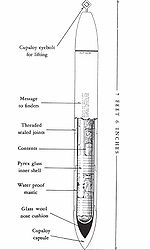
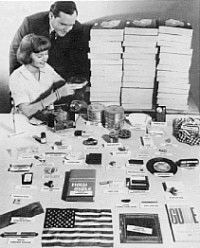
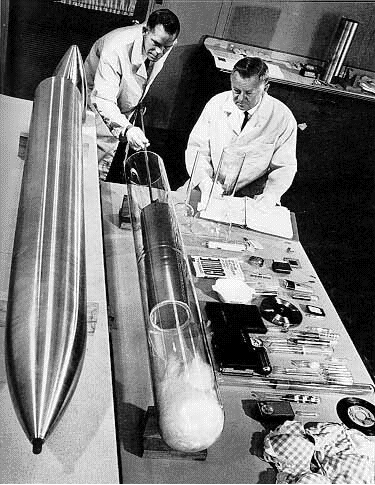
Time capsule
A time capsule is an historic cache of goods or information, usually intended as a method of communication with future people and to help future archaeologists, anthropologists, or historians...
s prepared by the Westinghouse Electric & Manufacturing Company
Westinghouse Electric (1886)
Westinghouse Electric was an American manufacturing company. It was founded in 1886 as Westinghouse Electric Company and later renamed Westinghouse Electric Corporation by George Westinghouse. The company purchased CBS in 1995 and became CBS Corporation in 1997...
: "Time Capsule I", created for the 1939 New York World's Fair
1939 New York World's Fair
The 1939–40 New York World's Fair, which covered the of Flushing Meadows-Corona Park , was the second largest American world's fair of all time, exceeded only by St. Louis's Louisiana Purchase Exposition of 1904. Many countries around the world participated in it, and over 44 million people...
; and "Time Capsule II", created for the 1964 New York World's Fair
1964 New York World's Fair
The 1964/1965 New York World's Fair was the third major world's fair to be held in New York City. Hailing itself as a "universal and international" exposition, the fair's theme was "Peace Through Understanding," dedicated to "Man's Achievement on a Shrinking Globe in an Expanding Universe";...
. Both are buried 50 feet below Flushing Meadows Park, the site of both world's fairs, the 1965 capsule 10 feet north of the 1938 one. Both are to be opened at the same time in the year 6939, five thousand years after the first capsule was sealed.
Construction
The two time capsules are bullet-shaped, measure 90 inches (2.29 m) in length, and have an exterior casing of about eight and three-eighths inches (21.1 cm) in diameter. Time Capsule I weighs about 800 pounds (363 kg), while Time Capsule II weighs about half that.Time Capsule I was made of a non-ferrous
Ferrous
Ferrous , in chemistry, indicates a divalent iron compound , as opposed to ferric, which indicates a trivalent iron compound ....
alloy
Alloy
An alloy is a mixture or metallic solid solution composed of two or more elements. Complete solid solution alloys give single solid phase microstructure, while partial solutions give two or more phases that may or may not be homogeneous in distribution, depending on thermal history...
called Cupaloy, created especially for this project. Designed to resist corrosion for 5,000 years, the alloy was made of 99.4% copper
Copper
Copper is a chemical element with the symbol Cu and atomic number 29. It is a ductile metal with very high thermal and electrical conductivity. Pure copper is soft and malleable; an exposed surface has a reddish-orange tarnish...
, 0.5% chromium
Chromium
Chromium is a chemical element which has the symbol Cr and atomic number 24. It is the first element in Group 6. It is a steely-gray, lustrous, hard metal that takes a high polish and has a high melting point. It is also odorless, tasteless, and malleable...
, and 0.1% silver
Silver
Silver is a metallic chemical element with the chemical symbol Ag and atomic number 47. A soft, white, lustrous transition metal, it has the highest electrical conductivity of any element and the highest thermal conductivity of any metal...
. Westinghouse claims it has the same strength as steel, yet will resist most corrosion
Corrosion
Corrosion is the disintegration of an engineered material into its constituent atoms due to chemical reactions with its surroundings. In the most common use of the word, this means electrochemical oxidation of metals in reaction with an oxidant such as oxygen...
over thousands of years like copper, because it becomes an anode
Anode
An anode is an electrode through which electric current flows into a polarized electrical device. Mnemonic: ACID ....
in electrolytic reactions, receiving deposits instead of wasting away like most iron-bearing metals. Time Capsule II was made of a stainless steel
Stainless steel
In metallurgy, stainless steel, also known as inox steel or inox from French "inoxydable", is defined as a steel alloy with a minimum of 10.5 or 11% chromium content by mass....
metal called "Kromarc", supplied by U.S. Steel
U.S. Steel
The United States Steel Corporation , more commonly known as U.S. Steel, is an integrated steel producer with major production operations in the United States, Canada, and Central Europe. The company is the world's tenth largest steel producer ranked by sales...
. Westinghouse Research Laboratories determined with extensive chemical testing that this new super stainless steel alloy would resist corrosion much like the alloy that was used for Time Capsule I. Invented by Frederick Charles Hull, Kromarc 55 Stainless Steel is composed of 52.60% iron
Iron
Iron is a chemical element with the symbol Fe and atomic number 26. It is a metal in the first transition series. It is the most common element forming the planet Earth as a whole, forming much of Earth's outer and inner core. It is the fourth most common element in the Earth's crust...
, 21.24% nickel
Nickel
Nickel is a chemical element with the chemical symbol Ni and atomic number 28. It is a silvery-white lustrous metal with a slight golden tinge. Nickel belongs to the transition metals and is hard and ductile...
, 15.43% chromium, 8.20% manganese
Manganese
Manganese is a chemical element, designated by the symbol Mn. It has the atomic number 25. It is found as a free element in nature , and in many minerals...
, 2.15% molybdenum
Molybdenum
Molybdenum , is a Group 6 chemical element with the symbol Mo and atomic number 42. The name is from Neo-Latin Molybdaenum, from Ancient Greek , meaning lead, itself proposed as a loanword from Anatolian Luvian and Lydian languages, since its ores were confused with lead ores...
, 0.22% silicon
Silicon
Silicon is a chemical element with the symbol Si and atomic number 14. A tetravalent metalloid, it is less reactive than its chemical analog carbon, the nonmetal directly above it in the periodic table, but more reactive than germanium, the metalloid directly below it in the table...
, 0.05% carbon
Carbon
Carbon is the chemical element with symbol C and atomic number 6. As a member of group 14 on the periodic table, it is nonmetallic and tetravalent—making four electrons available to form covalent chemical bonds...
, 0.013% phosphorus
Phosphorus
Phosphorus is the chemical element that has the symbol P and atomic number 15. A multivalent nonmetal of the nitrogen group, phosphorus as a mineral is almost always present in its maximally oxidized state, as inorganic phosphate rocks...
, and 0.012% sulfur
Sulfur
Sulfur or sulphur is the chemical element with atomic number 16. In the periodic table it is represented by the symbol S. It is an abundant, multivalent non-metal. Under normal conditions, sulfur atoms form cyclic octatomic molecules with chemical formula S8. Elemental sulfur is a bright yellow...
.
The contents for the time capsules were sealed inside an insulated airtight glass envelope with an interior diameter of six and a half inches (16.5 cm) and a length of about 81 inches (2 m). The interior of the glass envelope of Capsule I was filled with the inert gas nitrogen
Nitrogen
Nitrogen is a chemical element that has the symbol N, atomic number of 7 and atomic mass 14.00674 u. Elemental nitrogen is a colorless, odorless, tasteless, and mostly inert diatomic gas at standard conditions, constituting 78.08% by volume of Earth's atmosphere...
. The interior of the glass envelope of Capsule II was filled with the inert gas argon
Argon
Argon is a chemical element represented by the symbol Ar. Argon has atomic number 18 and is the third element in group 18 of the periodic table . Argon is the third most common gas in the Earth's atmosphere, at 0.93%, making it more common than carbon dioxide...
. The term "time capsule" was coined by George Edward Pendray
George Edward Pendray
George Edward Pendray was an American public relations counselor, author, foundation executive, and an early advocate of rockets and spaceflight.-Early life:...
for the New York 1939 World's Fair Westinghouse exhibit.
1939 "Time Capsule I" contents
Among the 35 small, everyday, physical items placed inside Time Capsule I were a fountain pen and an alphabet block set. Time Capsule I also contained 75 types of fabrics, metals, plastics, and seeds. Modern literature, contemporary art, and news events of the twentieth century were recorded on a microfilm "Micro-File" for placement in Time Capsule I; the "Micro-File" has over ten million words and a thousand pictures and came with a small microscope for viewing. There are also instructions included on how to make both a large microfilm viewer and a motion picture projector for the newsreelNewsreel
A newsreel was a form of short documentary film prevalent in the first half of the 20th century, regularly released in a public presentation place and containing filmed news stories and items of topical interest. It was a source of news, current affairs and entertainment for millions of moviegoers...
s.
Also included were copies of Life
Life (magazine)
Life generally refers to three American magazines:*A humor and general interest magazine published from 1883 to 1936. Time founder Henry Luce bought the magazine in 1936 solely so that he could acquire the rights to its name....
magazine, a kewpie doll
Kewpie Doll
"Kewpie Doll" can refer to any of the following:*Kewpie doll , a particular style of doll, awarded as a carnival prize and often collected*"Kewpie Doll ", a song recorded by Perry Como and Frankie Vaughan, among others...
, one dollar
Dollar
The dollar is the name of the official currency of many countries, including Australia, Belize, Canada, Ecuador, El Salvador, Hong Kong, New Zealand, Singapore, Taiwan, and the United States.-Etymology:...
in change, a pack of Camel cigarettes, a 15-minute RKO Pathe Pictures newsreel, and millions of words of text put on microfilm rolls which included a Sears Roebuck catalog, a dictionary
Dictionary
A dictionary is a collection of words in one or more specific languages, often listed alphabetically, with usage information, definitions, etymologies, phonetics, pronunciations, and other information; or a book of words in one language with their equivalents in another, also known as a lexicon...
, and an almanac
Almanac
An almanac is an annual publication that includes information such as weather forecasts, farmers' planting dates, and tide tables, containing tabular information in a particular field or fields often arranged according to the calendar etc...
. Seeds placed in the time capsule included wheat, corn, oats, tobacco, cotton, flax, rice, soy beans, alfalfa, sugar beets, carrots, and barley, all sealed in glass tubes.
The items that were selected to be put inside were based upon how well they chronicled 20th-century life in the United States
United States
The United States of America is a federal constitutional republic comprising fifty states and a federal district...
. During packaging of the contents under the direction of representatives of the United States National Bureau of Standards, each object was examined to determine whether it could be expected to last 5,000 years.
There were five main categories of objects to be put inside:
- Small articles of common use
- Textiles and materials
- Miscellaneous items
- Essay in microfilm
- RKO newsreel
1965 "Time Capsule II" contents
Again, there were five main categories of objects to be put inside:- Articles in common use
- Atomic energy
- Scientific developments
- Space
- Other
The "other" category included images of a guest book signed by visitors to the Westinghouse pavilion exhibit at the 1964 fair. Signers received tin pins, about 30mm (1.2 inches) across (roughly the size of an American fifty-cent piece
Half dollar (United States coin)
Half dollar coins have been produced nearly every year since the inception of the United States Mint in 1794. Sometimes referred to as the fifty-cent piece, the only U.S. coin that has been minted more consistently is the cent.-Circulation:...
), that said, My name is in the Westinghouse Time Capsule for the next 5,000 years. The book's pages were photographed onto acetate microfilm
Cellulose acetate
Cellulose acetate , first prepared in 1865, is the acetate ester of cellulose. Cellulose acetate is used as a film base in photography, as a component in some adhesives, and as a frame material for eyeglasses; it is also used as a synthetic fiber and in the manufacture of cigarette filters and...
and the message in a bottle
Message in a bottle
A message in a bottle is a form of communication whereby a message is sealed in a container and released into the sea or ocean...
placed in the Pyrex
Pyrex
Pyrex is a brand name for glassware, introduced by Corning Incorporated in 1915.Originally, Pyrex was made from borosilicate glass. In the 1940s the composition was changed for some products to tempered soda-lime glass, which is the most common form of glass used in glass bakeware in the US and has...
glass interior shell of the time capsule. The original 1965 capsule was then buried for posterity with an exact duplicate of articles in a "window" replica now residing at the Heinz History Center
Heinz History Center
The Senator John Heinz History Center, an affiliate of the Smithsonian Institution, is the largest history museum in the Commonwealth of Pennsylvania. Named after the late U.S. Senator H...
beside its sister replica capsule of cupaloy.
Book of Record
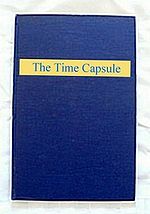
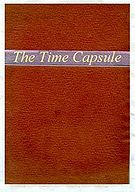
The purpose of the Book of Record is to preserve knowledge of the existence of the time capsule for 5000 years, and to provide assistance to the people of the year 6939 in locating and recovering it. Someone perhaps might find a copy of the over 3000 copies of the Book of Record distributed to museums, monasteries, and libraries worldwide. In order to avoid confusion about the 1965 time capsule, a supplement announcing Time Capsule II was sent to the original 3000 depositories of the 1938 Book of Record.
Should all present day methods of determining time be lost, then the time for what is now called 1939 Common Era
Common Era
Common Era ,abbreviated as CE, is an alternative designation for the calendar era originally introduced by Dionysius Exiguus in the 6th century, traditionally identified with Anno Domini .Dates before the year 1 CE are indicated by the usage of BCE, short for Before the Common Era Common Era...
can be recognized by calculation from astronomical data
Data
The term data refers to qualitative or quantitative attributes of a variable or set of variables. Data are typically the results of measurements and can be the basis of graphs, images, or observations of a set of variables. Data are often viewed as the lowest level of abstraction from which...
. In the year 1939, there were two eclipse
Eclipse
An eclipse is an astronomical event that occurs when an astronomical object is temporarily obscured, either by passing into the shadow of another body or by having another body pass between it and the viewer...
s of the moon
Moon
The Moon is Earth's only known natural satellite,There are a number of near-Earth asteroids including 3753 Cruithne that are co-orbital with Earth: their orbits bring them close to Earth for periods of time but then alter in the long term . These are quasi-satellites and not true moons. For more...
, falling on the third of May and the twenty-eighth of October. Also there were two eclipses of the sun
Sun
The Sun is the star at the center of the Solar System. It is almost perfectly spherical and consists of hot plasma interwoven with magnetic fields...
, an annular eclipse on the nineteenth of April, the path of annular eclipse grazing the North Pole
North Pole
The North Pole, also known as the Geographic North Pole or Terrestrial North Pole, is, subject to the caveats explained below, defined as the point in the northern hemisphere where the Earth's axis of rotation meets its surface...
of the earth
Earth
Earth is the third planet from the Sun, and the densest and fifth-largest of the eight planets in the Solar System. It is also the largest of the Solar System's four terrestrial planets...
, and a total eclipse on the twelfth of October, the total path crossing near the South Pole
South Pole
The South Pole, also known as the Geographic South Pole or Terrestrial South Pole, is one of the two points where the Earth's axis of rotation intersects its surface. It is the southernmost point on the surface of the Earth and lies on the opposite side of the Earth from the North Pole...
. The heliocentric longitudes of the planet
Planet
A planet is a celestial body orbiting a star or stellar remnant that is massive enough to be rounded by its own gravity, is not massive enough to cause thermonuclear fusion, and has cleared its neighbouring region of planetesimals.The term planet is ancient, with ties to history, science,...
s on the first of January at zero-hours Greenwich time were as follows:
- Planet
- Mercury
- Venus
- Earth
- Mars
- Jupiter
- Saturn
- Uranus
- Neptune
- Pluto
degrees
- 175
- 124
- 99
- 192
- 339
- 17
- 46
- 171
- 120
minutes
- 55
- 43
- 40
- 4
- 12
- 30
- 23
- 32
- 17
seconds
- 42
- 32
- 29
- 2
- 22
- 45
- 31
- 3
- 0
The mean position of the North Star Polaris
Polaris
Polaris |Alpha]] Ursae Minoris, commonly North Star or Pole Star, also Lodestar) is the brightest star in the constellation Ursa Minor. It is very close to the north celestial pole, making it the current northern pole star....
(Alpha Ursae Minoris) on the first of January was Right Ascension
Right ascension
Right ascension is the astronomical term for one of the two coordinates of a point on the celestial sphere when using the equatorial coordinate system. The other coordinate is the declination.-Explanation:...
, 1 hour, 41 minutes, 59 seconds; North Polar distance, 1 hour, 1 minute, and 33.8 seconds. Astronomers of the early twentieth century determined that such a combination of astronomical events is unlikely to recur for many thousands of years. The people of the future will therefore be able to determine the number of years that have elapsed since the capsule was buried by computing backward from their time.
Location of the two time capsules
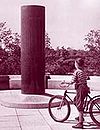
Its latitude and longitude coordinates of the burying place as determined by the U.S. National Geodetic Survey
U.S. National Geodetic Survey
National Geodetic Survey, formerly called the U.S. Coast and Geodetic Survey , is a United States federal agency that defines and manages a national coordinate system, providing the foundation for transportation and communication; mapping and charting; and a large number of applications of science...
was recorded in the Book of Record of the Time Capsule of cupaloy to within an inch (2.5 cm). The time capsule will likely move vertically or horizontally for geological reasons, so an alternate electromagnetic field method is provided for locating. It involves constructing a loop of wire 10 feet in diameter and putting an alternating current
Alternating current
In alternating current the movement of electric charge periodically reverses direction. In direct current , the flow of electric charge is only in one direction....
of between 1,000 and 5,000 hertz
Hertz
The hertz is the SI unit of frequency defined as the number of cycles per second of a periodic phenomenon. One of its most common uses is the description of the sine wave, particularly those used in radio and audio applications....
through it with a power of at least 200 watt
Watt
The watt is a derived unit of power in the International System of Units , named after the Scottish engineer James Watt . The unit, defined as one joule per second, measures the rate of energy conversion.-Definition:...
s. Then the detection of a "distortion field" with the use of a secondary loop of wire about a foot in diameter will indicate the exact location of the two metal alloy time capsules, assuming no other large metal objects are in the vicinity.
A 7-ton "permanent sentinel" granite monument made by the Rock of Ages Corporation
Rock of Ages Corporation
Rock of Ages Corporation is a granite quarrying and finishing company located in Graniteville, Vermont. It was founded in 1885. The company was one of the cemetery-related businesses profiled in the 2005 PBS documentary A Cemetery Special....
marks the position where the two time capsules are buried. The inscription on it reads,
-
-
- The Time Capsules Deposited September 23, 1938 And October 16, 1965
- By The Westinghouse Electric Corporation As A Record Of
- Twentieth Century Civilization To Endure For 5,000 Years.
-
Messages
The Book of Record of the Time Capsule, of which a copy was microfilmed and put inside Time Capsule I, contains written messages from three important men of the time:Albert Einstein
Albert Einstein
Albert Einstein was a German-born theoretical physicist who developed the theory of general relativity, effecting a revolution in physics. For this achievement, Einstein is often regarded as the father of modern physics and one of the most prolific intellects in human history...
's message,

Our time is rich in inventive minds, the inventions of which could facilitate our lives considerably. We are crossing the seas by power and utilise power also in order to relieve humanity from all tiring muscular work. We have learned to fly and we are able to send messages and news without any difficulty over the entire world through electric waves. However, the production and distribution of commodities is entirely unorganised so that everybody must live in fear of being eliminated from the economic cycle, in this way suffering for the want of everything. Further more, people living in different countries kill each other at irregular time intervals, so that also for this reason any one who thinks about the future must live in fear and terror. This is due to the fact that the intelligence and character of the masses are incomparably lower than the intelligence and character of the few who produce some thing valuable for the community. I trust that posterity will read these statements with a feeling of proud and justified superiority.
Robert Andrews Millikan's message,

At this moment, August 22, 1938, the principles of representative ballot government, such as are represented by the governments of the Anglo-Saxon, French, and Scandinavian countries, are in deadly conflict with the principles of despotism, which up to two centuries ago had controlled the destiny of man throughout practically the whole of recorded history. If the rational, scientific, progressive principles win out in this struggle there is a possibility of a warless, golden age ahead for mankind. If the reactionary principles of despotism triumph now and in the future, the future history of mankind will repeat the sad story of war and oppression as in the past.
Thomas Mann
Thomas Mann
Thomas Mann was a German novelist, short story writer, social critic, philanthropist, essayist, and 1929 Nobel Prize laureate, known for his series of highly symbolic and ironic epic novels and novellas, noted for their insight into the psychology of the artist and the intellectual...
's message,

We know now that the idea of the future as a "better world" was a fallacy of the doctrine of progress. The hopes we center on you, citizens of the future, are in no way exaggerated. In broad outline, you will actually resemble us very much as we resemble those who lived a thousand, or five thousand, years ago. Among you too the spirit will fare badly it should never fare too well on this earth, otherwise men would need it no longer. That optimistic conception of the future is a projection into time of an endeavor which does not belong to the temporal world, the endeavor on the part of man to approximate to his idea of himself, the humanization of man. What we, in this year of Our Lord 1938, understand by the term "culture" a notion held in small esteem today by certain nations of the western world is simply this endeavor. What we call the spirit is identical with it, too. Brothers of the future, united with us in the spirit and in this endeavor, we send our greetings.
Inscription on Time Capsules
The exterior of the 1938 time capsule is die-stamped with this message to anyone that might stumble upon it prior to the scheduled opening year of 6939 to preserve its integrity.
TIME CAPSULE OF CUPALOY, DEPOSITED ON THE SITE OF THE NEW YORK WORLD'S FAIR ON SEPTEMBER 23,1938,
BY THE WESTINGHOUSE ELECTRIC & MANUFACTURING COMPANY. IF ANYONE SHOULD COME UPON THIS CAPSULE
BEFORE THE YEAR A. D. 6939 LET HIM NOT WANTONLY DISTURB IT, FOR TO DO SO WOULD BE TO DEPRIVE THE
PEOPLE OF THAT ERA OF THE LEGACY HERE LEFT THEM. CHERISH IT THEREFORE IN A SAFE PLACE.
The 1965 time capsule exterior has no message.
Future languages
The Book of Record requests that its contents be translated into new languages as they develop. It contains a key with illustrations devised by Dr. John P. Harrington of the Smithsonian InstitutionSmithsonian Institution
The Smithsonian Institution is an educational and research institute and associated museum complex, administered and funded by the government of the United States and by funds from its endowment, contributions, and profits from its retail operations, concessions, licensing activities, and magazines...
to help future archaeologists with the English language,
since it was felt that all existing languages will be lost. It also includes an illustration showing exactly where each of the 33 sounds of 1938 English are formed in the oral cavity in what Dr. Harrington refers to as a "mouth map."
 |
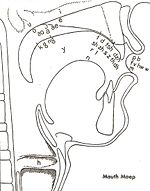 |
 |
 |
 |
 |
See also
- List of time capsules
- KEOKEOKEO is the name of a proposed space time capsule which was to have been launched in 2003 carrying messages from the citizens of present Earth to humanity 50,000 years from now, when it would re-enter Earth's atmosphere...
- Expo '70Expo '70was a World's Fair held in Suita, Osaka, Japan between March 15 and September 13, 1970. The theme of the Expo was "Progress and Harmony for Mankind." In Japanese Expo '70 is often referred to as Ōsaka Banpaku...
- Time capsuleTime capsuleA time capsule is an historic cache of goods or information, usually intended as a method of communication with future people and to help future archaeologists, anthropologists, or historians...
- 7th millennium7th millenniumThe 7th millennium is a period of time that will begin on January 1, 6001, and will end on December 31, 7000.-Astronomical events:These are astronomical dates, so they are given in the astronomical format of Year Month Day, which allows them to be ordered....
- Crypt of CivilizationCrypt of CivilizationThe Crypt of Civilization is a sealed airtight chamber located at Oglethorpe University in Atlanta, Georgia. The crypt consists of preserved artifacts scheduled to be opened in the year AD 8113...
- International Time Capsule SocietyInternational Time Capsule SocietyThe International Time Capsule Society , based at Oglethorpe University in Atlanta, Georgia, is an organization established to promote the study of time capsules...
Footnotes
Guide books
- Official Souvenir Book. New York World's Fair 1964/1965. Time Life, Inc. 1964.
- Official Guide, New York World's Fair 1964/1965. Time-Life Books. Time Life, Inc. 1964.
- Official Guide, New York World's Fair 1965. All New for 1965. Time-Life Books. Time Life, Inc. 1965.
Additional reading
- Jarvis, WilliamWilliam H. JarvisWilliam Herbert "Bill" Jarvis, PC is a former Canadian politician.Jarvis attended the London Central Collegiate Institute and the University of Western Ontario where he was a member of The Kappa Alpha Society....
Time Capsules: A Cultural History (2002) ISBN 0786412615 - Jacobs, ThornwellThornwell Jacobs-Early life:Jacobs was born in Clinton, South Carolina, February 15, 1877, at the Thornwell Orphanage. The orphanage was founded by his father, Reverend William Plumer Jacobs. His mother was Mary Jane Jacobs....
Step Down Dr. Jacobs: The Autobiography of an Autocrat. Atlanta, 1945. - Hilton, Suzanne Here Today and Gone Tomorrow. The Story of World's Fairs and Expositions. Westminster Press Books. 1978
Videos
- Westinghouse Time Capsule I color video with details of the contents (circa 1939) from YouTube
- New York Times Movie of the 1964 New York World's Fair contents of Westinghouse Time Capsule II
- Newsreel footage of Westinghouse's Time Capsule II being lowered into its resting place 50 feet below Flushing Meadows, Oct. 16, 1965
External links
- A Moment in Time
- A message to the future
- Time Capsules: Remains of the Day
- The New York World's Fair Community
- Photos of items in the 1939 time capsule
- Encyclopedia of library and information science
- The book of record of the time capsule of Cupaloy
- A Brief History Of Time Capsules By Jeremy Olshan
- Time Capsules: A Cultural History By William E. Jarvis
- Complete Contents List of the 1939 and 1965 Time Capsule
- The Story of the Westinghouse Time Capsule - 1939 New York's World's Fair
- New York's sacred meadow (The vital legacy of the Westinghouse time capsules)
- Time capsule descriptions in the 1965 New York World's Fair Official Guide brochure

